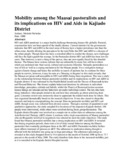| dc.description.abstract | HIV and AIDS pandemic is a major health challenge threatening human life globally. Pastoral, communities have not been spared of the deadly disease. Current statistics by the government indicates that HIV and AIDS in the rural areas of Kenya have a higher prevalence rate than the urban areas, thereby diluting the perception by the rural folks that HIV and AIDS is a disease of the urban people. Though there has been a consulted effort to combat the disease, new challenges still face the fight against this scourge. In the Pastoralist district HIV and AIDS has been low for years. This however, is now a thing of the past as; they are now equally faced by this dreaded disease.
The Maasai have various cultures that are admirable by many but, still have others which are enshrined into their social, cultural and economic lifestyles. Nomadic pastoralism is a way of life as' well as a coping mechanism for the Maasai people. It is a mitigation strategy against climate change and hence this mobility in search of pastures has to continue for these people to survive, however, it may be seen as a 'blessing in disguise' as this study reveals, that the Maasai are prone and susceptible to HIV and AIDS during these migrations.
This was a study on the relationship between Maasai pastoralist mobility and its implications on HIV and AIDS in Kajiado district. It was informed by the Health Belief model and the Theory of Reasoned Action and Planned Behavior. The former explain behavioral decisions by reference to individual knowledge, perception, attitude and beliefs; whilst the Theory of Reasoned Action assumes human beings are rational and key behaviors are under individual control. The key idea here being 'intention', what people intend to do and how they rationally go about achieving their goals. Literature review was intensively done to appreciate the related work done by others. This was organized thematically based on the research objectives. It was also meant to shape the research and help in conceptualizing the concept.
Data on pastoralist mobility and HIV and AIDS, though scant, was collected from diverse sources. Through a mixture of quantitative and qualitative approaches, the study sampled five locations of the expansive Kajiado district. 100 people were interviewed, while others were involved during focus group discussions. The Kajiado district Hospital was involved as a sample site to collect data on adherence among the Anti-Retroviral Therapy (ART) clients. Locations with a high concentration of Maasai pastoralist who are frequently involved in migrations was selected to meet the study objectives.
The study found that Maasai pastoralist mobility has a strong implication on HIV and AIDS. It revealed that during migration periods, there exist a lot of risky sexual behavior among the Maasai pastoralist that eventually predispose them to the HIV and AIDS. Pastoralist mobility further more affects treatment of persons on ART. The adherence to medication during drought is affected with the defaulter rate going up in huge percentage. The adherence percentage as revealed in this study dropped down to 54.4 percent in the month of October 2009 up from 75.7 percent in the month of May 2009. The study therefore links these to the increased mobility, just as it is recorded at the Kajiado district Hospital records. | en_US |

